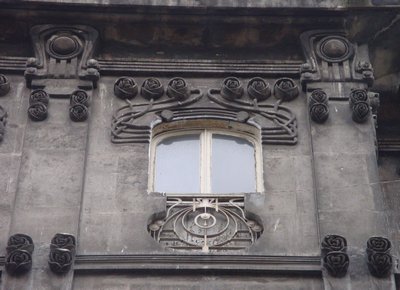In the cool of early evening I thought I’d take a turn around the back streets of Eminönü. It always surprises me how busy this area is, yet how little the crowds of passers-by actually seem to notice what they’re passing. For most it’s just a jam-packed thoroughfare leading to the waterfront with people pausing only at the post office (and even that must be becoming a less frequent occurrence as our lives migrate online) and perhaps at the famous Ali Muhiddin Hacı Bekir Turkish delight shop. In reality, though, there are as many imposing 19th-century buildings shoehorned into this area as there are across the Golden Horn on İstiklal Caddesi. The difference is that these mostly served a workaday function as modern hans and office blocks rather than as more glamorous consulates. But it’s here rather than on İstiklal that you can see an indigenous Turkish style of architecture battling it out for supremacy with the imported Western styles that rule the roost on İstiklal: Art Nouveau and Neoclassicism doing battle with First National Architecture which is conspicuous by his absence over there.
Since I’m staying in Sultanahmet I stroll first down Yerebatan Caddesi, noting the enormous difference made to it now that the social security office that used to stand beside the soaring yellow Tourism Police office has been torn down. Across the road from it another government office has given way to a new branch of the Crowne Plaza whose restaurant boasts a great view of Ayasofya across the vacant lot. The biggest winner from this? The renovated And Hotel, once very much an also-ran, now looking straight out onto a spectacular view.
My walk takes me past the shrouded building site behind which the late 16th-century Hadım Hasan Paşa Medresesi is finally getting a belated facelift. Then I cross over busy Ankara Caddesi and head down Türkocağı Caddesi towards Eminönü passing the enormous İstanbul Erkek Lisesi (Boys High School), actually a co-ed establishment that started life as the home of the department charged with sorting out the late Ottoman Empire’s sovereign debt. The road bears right and takes me past a forgotten work of Sinan, the Rüstem Paşa Medresesi, where I’m startled to find more restoration work in progress, not because restoration isn’t a good thing, generally speaking, but because it has already been restored once before and yet was never open on any of my previous visits.
Kicking question marks about wasted public funds into the long grass, I keep walking downhill until the road sweeps to the left and I can admire, on the right, one of the two mosaics celebrating the weaving process that adorn the Katırcıoğlu Han. These mosaics must have gone up in the 1960s or 70s and strike me as two of the most vulnerable artworks in the city. Few people seem to have much good to say about the artistic legacy of the ’60s and ’70s, so it’s all too easy to imagine a day when the wrecker’s ball will see off minor works such as this that will not have been sufficiently appreciated until they’re gone.
In Sultanhamam Meydanı the builders are hard at work relaying the pavements and landscaping the square. I take a sharp left and detour up the hill to admire what I think the finest of all the forgotten hans in this area, the imposing Hamdi Bey Geçidi whose facade must surely have been modelled on the Library of Celsus in Ephesus. Then I double-back on myself to amble along Aşirefendi Caddesi, the road that runs behind the Büyük Postane (Main Post Office) and is lined with fine 19th-century hans, early office blocks in a variety of imported Western architectural styles that recall the days when this was the hub of commerce backing onto the port and right beside the new railway station at Sirkeci in the more Turkish old part of İstanbul.
Flipping back in front of the post office I pause to admire the soot-blackened stone roses adorning the facade of the Art Nouveau Vlora Han, the Eminõnü echo of the Casa Botter on İstiklal Caddesi and in just as disconsolate a state of repair. Its time may come soon though since some of the hans along this street have recently been scrubbed up and found new uses as shops and restaurants. At the end of the street the heavy Neoclassical Deutsche Bank building is also long overdue for a clean-up. I fully expect it to start any day soon.
To get to the water I slip down the alley that leads to the Hamidiye Türbesi where Sultans Abdülhamid I and Mustafa IV are buried. Beautifully restored, this tomb is especially popular with visitors from the Islamic world because amongst its treasures it counts a set of Mohammed’s footprints that are a little easier to see than those on display in the overcrowded Topkapı Palace. Immediately across the road stands what was once the Fourth Vakıf Han building, a masterpiece by the First National architect, Kemaleddin Bey, that how houses the Legacy Ottoman Hotel.
With the sun starting to set I continue along the road and pass a wonderful sebil, an outlying part of the Yeni Cami (New Mosque) complex where water used to be dispensed to passers-by and grind my teeth with irritation at the ugly modern self-service water dispenser jammed up against its marble finery. The road continues to Eminönü Meydanı passing the unexpectedly interesting Türkiye İş Bankası Müzesi (Museum), the tombs of Sultans Mehmed IV, Mustafa III. Ahmed III, Mahmud I, Osman III and Murad V as well as the powerful queen mother Hatice Turhan Sultan, and then the Yeni Cami, but I cross the road and bear right past the all but invisible Hidayet Cami, designed by Alexandre Vallaury, and stroll down to the ferry terminals along Yalı Köşkü Caddesi, pausing to admire my favourite overlooked work of First National Architecture, the lovely but hopelessly neglected Liman Han, its facade almost completely covered with bright blue tiles.


